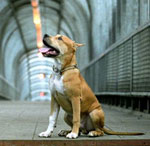Teams the dog. Sit!
 The command "Sit!" is the starting point for many subsequent, more complex commands. Therefore, to start training the dog follows with the training of the execution of the command "Sit!".
The command "Sit!" is the starting point for many subsequent, more complex commands. Therefore, to start training the dog follows with the training of the execution of the command "Sit!"."Sit!"
The command "Sit!"You can give the dog the appropriate word or gesture - the right arm is bent at the elbow, the palm is open and raised vertically." The dog is trained with a treat using a sweet tooth, lightly pressing the lower back (closer to the rump) and pulling the leash back and forth.
Develop a conditioned reflex to sit down on commandcan be in two ways: tasteful and contrastive. The skill, which is developed with the help of contrast reception, is more stable. Vkusopooschritelny method is often used when training young or too malicious dogs, dogs with a predominance of food instinct.
Vkusooposhritelny reception: The dog is to the left of the trainer, onshort leash. In the right hand, you should keep a treat. The trainer should call the dog's nickname and after a short pause, give the command "Sit!" with an orderly intonation, to bring a hand with a delicacy to the muzzle of the dog, letting him sniff, and then smoothly raise his hand over the dog's head and lead a few back towards the withers. The dog, trying to get a treat, raises its head, reaches for it, and as the leash keeps it from leaping, it throws back its head and gradually sits down. As soon as the dog sits down, it is necessary to encourage her with a delicacy, stroking and exclamation "Okay!". This way of training is not suitable for temperamental dogs, in which the food instinct is too strong. These dogs will try to snatch a treat, they will spin on the spot, and the conditioned reflex to the team will be difficult to fix.
Contrast reception: put the dog on a short leash near yourleft foot. Turn to her half-turned and take the leash in your right hand 10-15 cm from the collar. After giving the command "Sit!" In the command intonation, put the left hand (palm down, thumb to yourself) on the dog's lower back, closer to the sacrum, and press, forcing the dog to sit down. At the same time, with your right hand, pull the leash up and back. As soon as the dog sits, repeating the command "Sit!", Stroke it and give it a treat. Having sustained the dog in the sitting position 5-10 seconds, give the command "Walk!". Repeat the exercise after 5-6 minutes. After the team has worked, you can enter a gesture. After a while, when the dog gets used to responding to the gesture, the command can not be pronounced.
When you accustom a dog to a gesture, stand in front ofher, gradually increasing the distance. If at your departure the dog tries to get up and follow you, immediately give the command "Sit!", Loudly and with threatening intonation. If the dog still gets up and comes to you, then quickly approach her, menacingly say: "Sit!", If necessary, seat her in the same place. Simultaneously with increasing the distance between you and the dog, increase the dog's holding time in a sitting position.
The skill is considered worked out, if the dog is clear,quickly and faultlessly sits from any position, at the command or gesture of the trainer, being away from him at a distance of 15 m, and keeps this position with an exposure of up to 15 s.
It is undesirable to call a dog fromsitting position, this can weaken the exposure. Do not also say the command many times: say "Sit!" and require execution (alone or with your help). Excessive punishment also does not accelerate the assimilation of the team.













